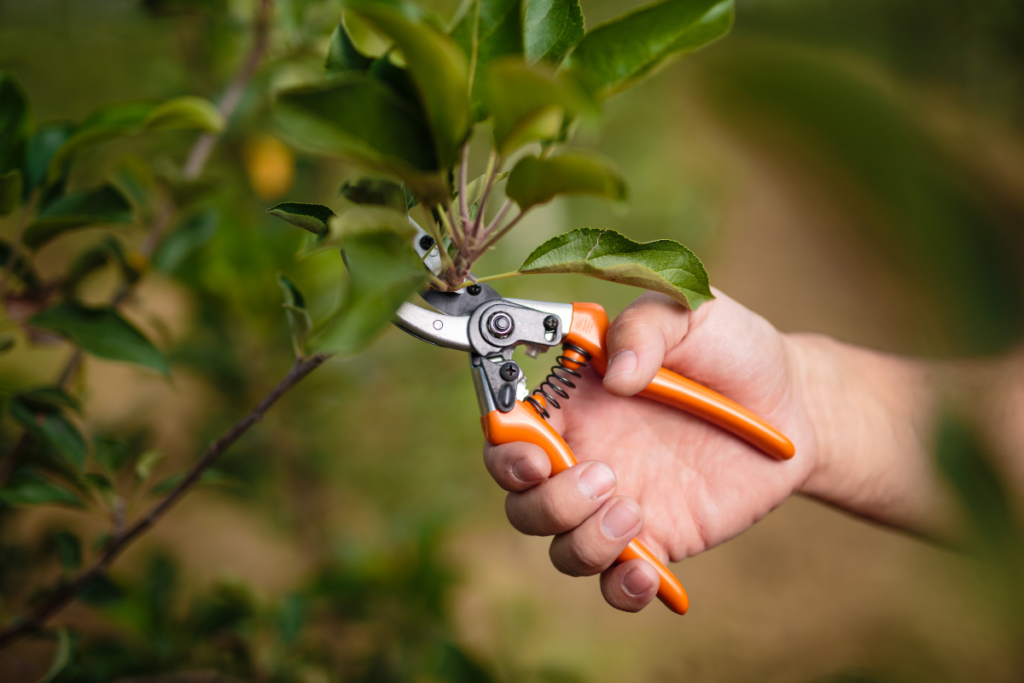Tree pruning goes beyond aesthetics; it is essential for maintaining tree health and vitality. Whether you manage a modest backyard garden or oversee a sprawling landscape filled with trees, grasping the significance of pruning can greatly enhance the well-being and longevity of your green companions. Proper pruning practices ensure that trees allocate resources efficiently, promoting vigorous growth and resilience against diseases and environmental stresses. By removing dead or diseased branches and shaping the tree’s structure, pruning fosters optimal conditions for healthy growth and enhances the beauty of your outdoor environment.
What is Tree Pruning?
Tree pruning involves selectively removing parts of a tree, such as branches or roots, to enhance its health and structure. Unlike random cutting, pruning is a strategic process aimed at eliminating dead, diseased, or overgrown branches that could impede growth or jeopardize the tree’s stability. By carefully shaping the tree through pruning, gardeners and arborists ensure optimal resource allocation for new growth and mitigate risks associated with weak or encroaching branches. This meticulous approach not only supports the tree’s overall health and longevity but also enhances safety and aesthetic appeal within its environment. Understanding the fundamentals of pruning empowers caretakers to foster robust, resilient trees that thrive in their natural habitats.

Promoting Healthy Growth
One of the primary reasons tree pruning is essential is its role in promoting healthy growth. By removing dead or diseased branches, pruning prevents the spread of decay and infection to other parts of the tree. This proactive approach helps the tree allocate resources more efficiently, directing energy towards new growth and strengthening existing limbs.
Pruning also stimulates the development of new buds and branches, leading to a denser and more robust canopy. This not only improves the overall appearance of the tree but also enhances its ability to withstand environmental stressors such as drought or pests. Additionally, promoting airflow and sunlight penetration through proper pruning fosters optimal conditions for photosynthesis, crucial for the tree’s nutrient production and overall vigor.
Enhancing Structural Integrity
Trees, like any living organism, need a strong foundation to thrive. Proper pruning enhances the structural integrity of trees by eliminating weak or crossing branches that could become hazardous over time. This not only reduces the risk of branches falling unexpectedly but also improves the tree’s ability to withstand harsh weather conditions such as storms or heavy winds.
Moreover, pruning encourages a strong central leader in trees that naturally grow upright, such as conifers. This central leader provides stability and balance to the tree’s crown, preventing it from becoming lopsided or top-heavy. By shaping the tree’s structure through selective pruning, you ensure it grows in a balanced and sustainable manner, contributing to its long-term health and resilience.
Stimulating Fruit Production
For fruit-bearing trees, pruning is a crucial practice that directly impacts the quality and quantity of fruit produced. By selectively pruning branches, gardeners can improve air circulation and sunlight exposure within the canopy, optimizing conditions for fruit development. This results in healthier fruits that are less prone to diseases and pests, ensuring a bountiful harvest season after season.
Pruning also promotes the growth of fruiting spurs, which are specialized branches that bear flowers and fruit. By strategically pruning to encourage the formation of these spurs, you maximize the tree’s fruit-bearing potential and extend its productive lifespan. This targeted approach not only benefits home orchards but also commercial fruit growers seeking to maximize yield and quality.
Shaping and Aesthetic Appeal
While the functional benefits of pruning are significant, it also plays a role in enhancing the aesthetic appeal of trees and landscapes. Properly pruned trees exhibit a balanced and pleasing form, complementing their surroundings and adding value to residential and commercial properties alike.
Beyond mere aesthetics, shaping trees through pruning can influence their growth habits and overall appearance. Whether creating a formal hedge, training young trees into specific forms, or rejuvenating older specimens, skilled pruning techniques can sculpt trees to fit their environment and desired landscape design. This artistic aspect of pruning allows homeowners and landscape professionals to create visually stunning outdoor spaces that harmonize with natural surroundings.
Mitigating Safety Risks
Overgrown or improperly maintained trees can pose serious safety risks to property and individuals. Branches that hang over roofs, power lines, or walkways are accidents waiting to happen. Regular pruning helps mitigate these risks by removing potentially hazardous branches and reducing the likelihood of property damage or personal injury caused by falling limbs.
Furthermore, proactive pruning reduces the likelihood of structural failure during severe weather events. By identifying and removing weak or diseased branches before they become problematic, you enhance the overall safety of your property and minimize the need for emergency tree care in the future. This preventive approach not only protects your investment in landscaping but also ensures the safety and well-being of everyone who enjoys your outdoor spaces.
When and How to Prune
The timing and techniques of pruning vary depending on factors such as tree species, climate, and desired outcomes. Generally, pruning is best performed during the dormant season when trees are not actively growing. This minimizes stress on the tree and allows wounds to heal more effectively.
Winter pruning, in particular, is advantageous for deciduous trees, as it allows for better visibility of the tree’s structure and encourages vigorous spring growth. In contrast, pruning evergreen trees is often recommended in late winter or early spring to coincide with their dormant periods. Techniques such as crown thinning, crown raising, and crown reduction are employed to achieve specific objectives while preserving the tree’s health and natural form.
Professional Expertise
While basic pruning can be done by homeowners, hiring a certified arborist or tree care professional is advisable for more complex pruning tasks or for trees of significant size. These experts have the knowledge and specialized equipment to assess tree health, identify pruning needs, and execute pruning techniques safely and effectively. Investing in professional tree care ensures optimal results and contributes to the long-term health of your trees.
Certified arborists not only understand the unique needs of different tree species but also adhere to industry standards and best practices for tree pruning. They can recommend tailored pruning schedules and techniques based on your specific goals and the health of your trees. Whether you need routine maintenance pruning, hazard reduction, or aesthetic enhancement, partnering with a qualified arborist ensures that your trees receive the care they need to thrive.
The Role of Pruning in Disease Prevention
Proper tree pruning plays a crucial role in preventing the spread of diseases among trees. By selectively removing dead, diseased, or infested branches, gardeners and arborists effectively eliminate potential sources of infection. Diseased branches not only compromise the aesthetic appeal of trees but also serve as entry points for pathogens and pests. Through strategic pruning, these vulnerable parts are promptly removed, preventing the further spread of diseases throughout the tree’s canopy and beyond. This proactive approach not only preserves the tree’s health but also safeguards neighboring plants from potential contamination.
Furthermore, pruning promotes air circulation and sunlight penetration within the tree’s canopy, creating an environment that is less favorable for disease development. Adequate airflow reduces humidity levels, which can inhibit fungal growth and other moisture-related diseases. Additionally, by enhancing sunlight exposure to inner branches and foliage, pruning stimulates photosynthesis, bolstering the tree’s immune system and overall vigor. By incorporating disease prevention into regular pruning practices, caretakers ensure that trees remain resilient against common ailments, fostering a thriving and disease-free landscape.
Conclusion
Understanding why tree pruning is essential empowers homeowners and property managers to nurture healthy, thriving trees. From promoting robust growth and structural integrity to safeguarding against diseases and safety hazards, the benefits of regular pruning are indispensable for maintaining a vibrant landscape. By incorporating proper pruning practices, such as removing dead or diseased branches and shaping the tree’s canopy, individuals can enhance both the health and aesthetic appeal of their outdoor spaces. Whether you have a small backyard garden or oversee a large commercial property, prioritizing tree care through pruning ensures longevity and resilience against environmental challenges.
For expert tree pruning services in Ocala, trust Tree Service Legends to care for your trees with precision and professionalism. Located at 3585 SW 38th Terrace N105, Ocala, our team is dedicated to enhancing the health and beauty of your landscape. Contact us today at (352) 558-2348 to schedule a consultation or learn more about our comprehensive tree care solutions. Let us help you create a safer, healthier environment for your trees to thrive.
